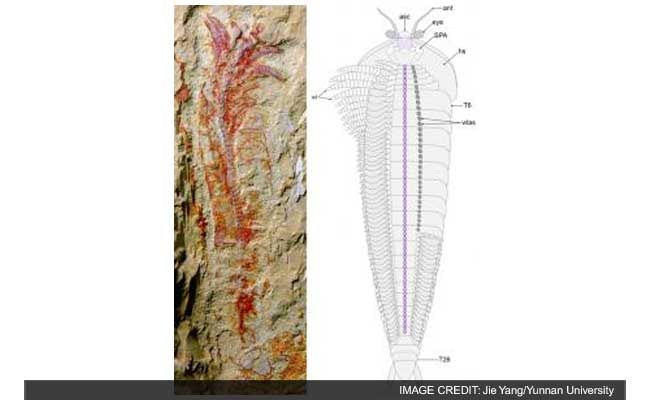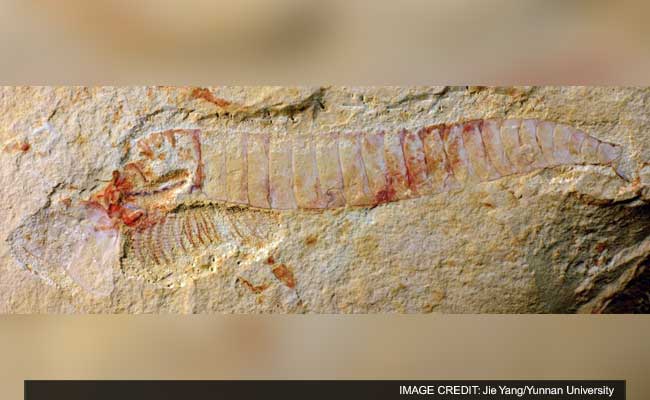
Complete specimen of Chengjiangocaris kunmingensis, which shows some of the best and most well-preserved nerves ever seen in an animal of its era.
Chengjiangocaris kunmingensis wasn't exactly a beautiful animal: The crustacean-like Cambrian creature had a long, segmented body and an unholy number of legs that it used to scuttle across the ocean floor. But scientists are oohing and ahhing over the ugly arthropod anyway, and for good reason. The nervous system of one 520 million-year-old specimen shows some of the best and most well-preserved nerves ever seen in an animal of that era.
According to a study published Monday in the Proceedings of the National Academy of Sciences, the fossil may be the oldest and most detailed example of a central nervous system yet identified, with even individual nerves -- rarely preserved soft tissue -- visible enough to study.
Most fossil specimens are the remains of teeth (the hardest part of the body) or bones. Soft tissues, such as nerves, are much more likely to decay over time. So studying the long evolution of nervous systems can be a daunting prospect.
The fossil described in the new paper, which was found in southern China, is a rare exception.

Researchers from Yunnan University had to take special precautions to maintain the integrity of the delicate system.
"Using a fine needle and a steady hand, they chipped away parts of the rock to reveal the preserved internal features; they only needed a bit of nerve cord sticking out to have a good idea of where to continue excavating in the fossil," study co-author Javier Ortega-Hernandez of the University of Cambridge told The Washington Post in an email. "As usually happens with amazing discoveries, when I first saw the material it took me a bit of time to make sense of what I was looking at. After a little while, however, excitement kicked in after realizing that not only was this an exquisitely preserved nerve cord, but also that it has impossibly thin individual nerves sticking out from it!" he wrote.
That nerve cord -- analogous to the spinal cord found in modern vertebrates -- ran through its entire body. Bead-like clusters of nerve tissue called ganglia (which act like "mini-brains along the nerve cord," according to Ortega-Hernandez) each controlled a single pair of the animal's many legs.
Scientists have seen animals of similar age with preserved ganglia before, which Ortega-Hernandez believes is the result of the fatty content of that nerve tissue -- some of those chemicals may make it more prone to fossilization than other soft stuff in the body is. But Chengjiangocaris kunmingensis also shows a few dozen delicate, tiny individual nerve fibers sprouting out from the nerve cord and ganglia.
That may be an important clue in the evolutionary mystery.
"By contrast, arthropods of today only have the ganglia, but a very restricted number of the lateral nerves," he said. "The only living group today where scientists have found dozens of individual nerve fibers structured like these are priapulids (penis worms) and onychophorans (velvet worms), which are cousins of arthropods.
"Putting all of this together, the new fossils of C. kunmingensis allow us to recognize that the evolution of the nervous system in living arthropods involved the loss of some of these nerves, and that their presence in the fossil and the velvet worms is a very ancestral feature," Ortega-Hernandez explained.
The researchers will need to find even more of these intact nervous systems if they want to complete the puzzle. But that could prove difficult: After all, the specimen described in the study was a rare bird (erm, rare ancient shrimp-y thing).
"We have to bear in mind that each nerve strand is about 10 times thinner than a human hair," Ortega-Hernandez said, "so being able to recognize this level of neurological detail is simply amazing."
© 2016 The Washington Post
(This story has not been edited by NDTV staff and is auto-generated from a syndicated feed.)
According to a study published Monday in the Proceedings of the National Academy of Sciences, the fossil may be the oldest and most detailed example of a central nervous system yet identified, with even individual nerves -- rarely preserved soft tissue -- visible enough to study.
Most fossil specimens are the remains of teeth (the hardest part of the body) or bones. Soft tissues, such as nerves, are much more likely to decay over time. So studying the long evolution of nervous systems can be a daunting prospect.
The fossil described in the new paper, which was found in southern China, is a rare exception.

That nerve cord -- analogous to the spinal cord found in modern vertebrates -- ran through its entire body.
Researchers from Yunnan University had to take special precautions to maintain the integrity of the delicate system.
"Using a fine needle and a steady hand, they chipped away parts of the rock to reveal the preserved internal features; they only needed a bit of nerve cord sticking out to have a good idea of where to continue excavating in the fossil," study co-author Javier Ortega-Hernandez of the University of Cambridge told The Washington Post in an email. "As usually happens with amazing discoveries, when I first saw the material it took me a bit of time to make sense of what I was looking at. After a little while, however, excitement kicked in after realizing that not only was this an exquisitely preserved nerve cord, but also that it has impossibly thin individual nerves sticking out from it!" he wrote.
That nerve cord -- analogous to the spinal cord found in modern vertebrates -- ran through its entire body. Bead-like clusters of nerve tissue called ganglia (which act like "mini-brains along the nerve cord," according to Ortega-Hernandez) each controlled a single pair of the animal's many legs.
Scientists have seen animals of similar age with preserved ganglia before, which Ortega-Hernandez believes is the result of the fatty content of that nerve tissue -- some of those chemicals may make it more prone to fossilization than other soft stuff in the body is. But Chengjiangocaris kunmingensis also shows a few dozen delicate, tiny individual nerve fibers sprouting out from the nerve cord and ganglia.
That may be an important clue in the evolutionary mystery.
"By contrast, arthropods of today only have the ganglia, but a very restricted number of the lateral nerves," he said. "The only living group today where scientists have found dozens of individual nerve fibers structured like these are priapulids (penis worms) and onychophorans (velvet worms), which are cousins of arthropods.
"Putting all of this together, the new fossils of C. kunmingensis allow us to recognize that the evolution of the nervous system in living arthropods involved the loss of some of these nerves, and that their presence in the fossil and the velvet worms is a very ancestral feature," Ortega-Hernandez explained.
The researchers will need to find even more of these intact nervous systems if they want to complete the puzzle. But that could prove difficult: After all, the specimen described in the study was a rare bird (erm, rare ancient shrimp-y thing).
"We have to bear in mind that each nerve strand is about 10 times thinner than a human hair," Ortega-Hernandez said, "so being able to recognize this level of neurological detail is simply amazing."
© 2016 The Washington Post
(This story has not been edited by NDTV staff and is auto-generated from a syndicated feed.)
Track Latest News Live on NDTV.com and get news updates from India and around the world

